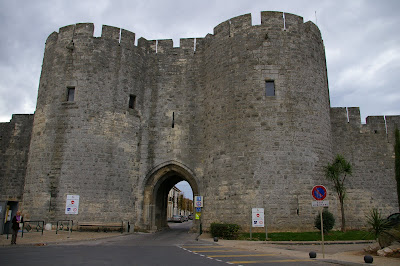Aigues-Mortes

So here we have two views of the intact medieval walls of Aigues-Mortes, in southern France near the coast. Aigues-Mortes, which means "dead water" in the old local dialect, is built in the marshland of the Camargues, a perfectly flat stretch of wetlands that forms the Rhone delta. Aigues-Mortes isn't on the sea, but is only a canal and a large lagoon away.
The Camargues is famous for its wild horses, its flamingos, and its bulls. "Bull" is much featured on local menus--- it's food for poor folks, tough but flavorful. Though we had a couple bad restaurant experiences in  Aigues-Mortes, neither had to do with bull--- one was a bad restaurant with broken sewer pipes that filled the restaurant with an unmistakable fecal odor, and the other was a waiter who gave us a wine that was much cheaper than the one we ordered, doubtless intending to pocket the difference. (The fact that he kept his hand over the label was a clue: I made him bring the correct wine.)
Aigues-Mortes, neither had to do with bull--- one was a bad restaurant with broken sewer pipes that filled the restaurant with an unmistakable fecal odor, and the other was a waiter who gave us a wine that was much cheaper than the one we ordered, doubtless intending to pocket the difference. (The fact that he kept his hand over the label was a clue: I made him bring the correct wine.)
 Aigues-Mortes, neither had to do with bull--- one was a bad restaurant with broken sewer pipes that filled the restaurant with an unmistakable fecal odor, and the other was a waiter who gave us a wine that was much cheaper than the one we ordered, doubtless intending to pocket the difference. (The fact that he kept his hand over the label was a clue: I made him bring the correct wine.)
Aigues-Mortes, neither had to do with bull--- one was a bad restaurant with broken sewer pipes that filled the restaurant with an unmistakable fecal odor, and the other was a waiter who gave us a wine that was much cheaper than the one we ordered, doubtless intending to pocket the difference. (The fact that he kept his hand over the label was a clue: I made him bring the correct wine.)The medieval walls are completely intact and you can walk clean around the town on the battlements if you so desire. (I walked for a hundred or so yards, then decided that one battlement was more or less like the next.)
The reason the walls have remained unchanged since the 13th Century has to do with the reason the walls were built in the first place. At that time in history, the Kingdom of France had no port on the south coast. They did, however, have the Camargue, and Louis IX--- later canonized--- ordered the little village of Aigues-Mortes made into a proper port, with a proper port's walls. It was from Aigues-Mortes that Louis launched his disastrous Seventh Crusade, which ended with the king a prisoner in Egypt, to be ransomed by a sum equal to the entire French yearly budget. By the time Louis left on the equally-disastrous Eighth Crusade, which ended in his death, he had acquired the port of Marseilles, and left from there.
Which explains why Aigues-Mortes is so untouched: history passed it by, and moved to Marseilles. Aigues-Mortes never had the money to tear down their walls and build skyscrapers. Louis XIV later used the keep to house the Protestants that he was persecuting: one pious Huguenot lady stayed there for 29 years.
There is a statue of St. Louis in the town square, looking martial and rather dim, which apparently he was in life. There is a nice, smallish romanesque church. The buildings in the town look 17th Century to me--- at any rate they aren't medieval.
The Camargue is quite lovely, in its desolate way. It's a noted place for birdwatching, but in November there didn't seem to be many birds around.
I did nearly plow my car into one of the famous Camargue wild horses, but it decided at the last second not to bolt across the road in front of me.
I wonder if Louis' crusaders had to cope with the same kind of scamming waiters that I encountered.
Labels: Aigues-Mortes


2 Comments:
Magnificent walls! (But it looks like a single-lane gateway.)
--Bonnie
Well goodness me, tear the whole damned thing down so that SUVs can drive through six abreast.
Post a Comment
<< Home